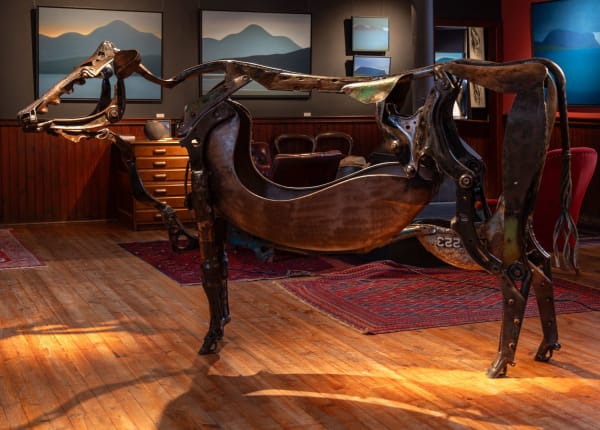Helen Denerley made a horse in 1999. She named it 'Millie' and it was her millennium piece, something to celebrate both the coming chapter for humanity and the new period that her work would enter after the success of her wolf pack. People today still remind me of the wolves - the alpha male, the snarl of the rising youth, the slightly bowed-legs of the old male and the vitality of the young female. How does an artist keep rising after a success? Millie the Horse did this. It introduced positive space into Denerely's work and, when installed outside, it shared the field with its flesh-and-blood brothers and sisters a new natural way.
Twenty-five years has passed since then, and Helen Denerley has proved that she is still facing forwards on the artistic bus that leads to fresh places. Sculpture, especially on Denerley's scale is mentally and physically demanding. Others may have been tempted to push the welder to the back of the workshop and rest on past successes - but if anything, Denerley is ramping up the speed. Last year, she made a giant spider and an 8-meter high Brâncuși infinity column. This year, for the first time, she has made humans and, our second work of the week, her dairy cow.
The miracle of Maisie number one is that it makes me realise truths about cows that are easily passed by. Cows are big animals. This one takes four people to pick-up and transport. It would be similar for her flesh sisters. Most surprising of all is the size of the feet that takes this weight. They are dainty, too small, so even Maisie is forced to take short steps.
The miracle of Maisie number two, is the beauty of its components. Her belly is made from a vintage car's front wings and its udders from an old motorbike's mudguard. These are beautiful objects, curved and patinated. Her ears are from barley scoops of some sort and her strong chin is from a suspension arm. Her back is from a plough share. The beauty of these objects reminds me of the lives inanimate objects can live, and the moments they have witnessed before Denerley saved them from the scrap heap. Sometimes it is important to face backwards on the bus and see where you have been.
The miracle of Maisie number three, is the gift of space. Denerley calls it positive space, rather than negative space. The space a cow doesn’t occupy is just as important as the space it does. The ‘empty bits’ are what gives it life and a geography it can wander into. In a drawing, a line is two-dimensional but, when well-placed, it allows us to see not only three-dimensions but also time, expression, weight and the personality of the artist. This is where the magic happens. The smallest mark or the strongest straight line, in a drawing, can occupy space in a quantum way, and become anything. It is the same in a Denerley sculpture. A small, discarded object - an old hammer, for example – can become a ballet-shoed foot that can hold anything, even the two-toed weight of a cow.





